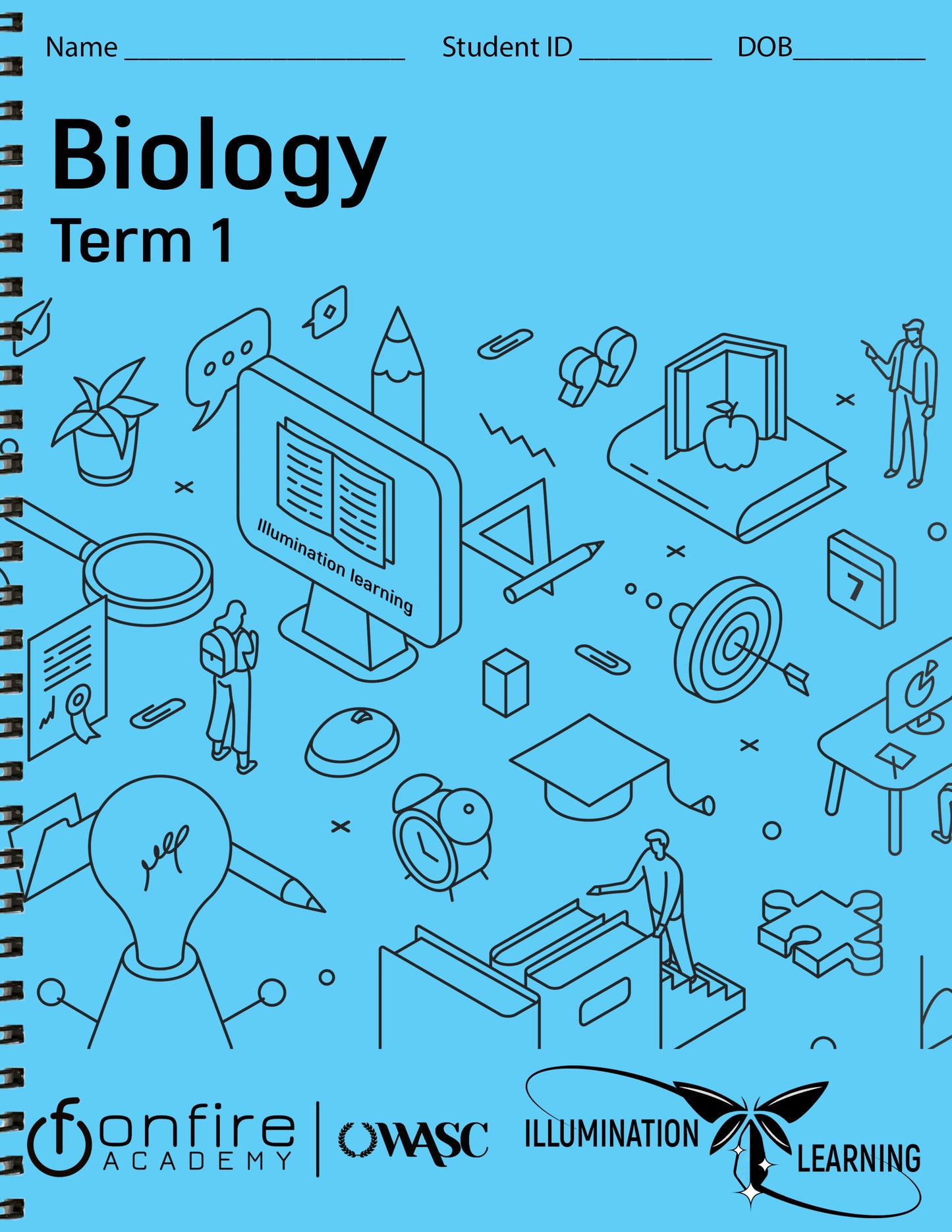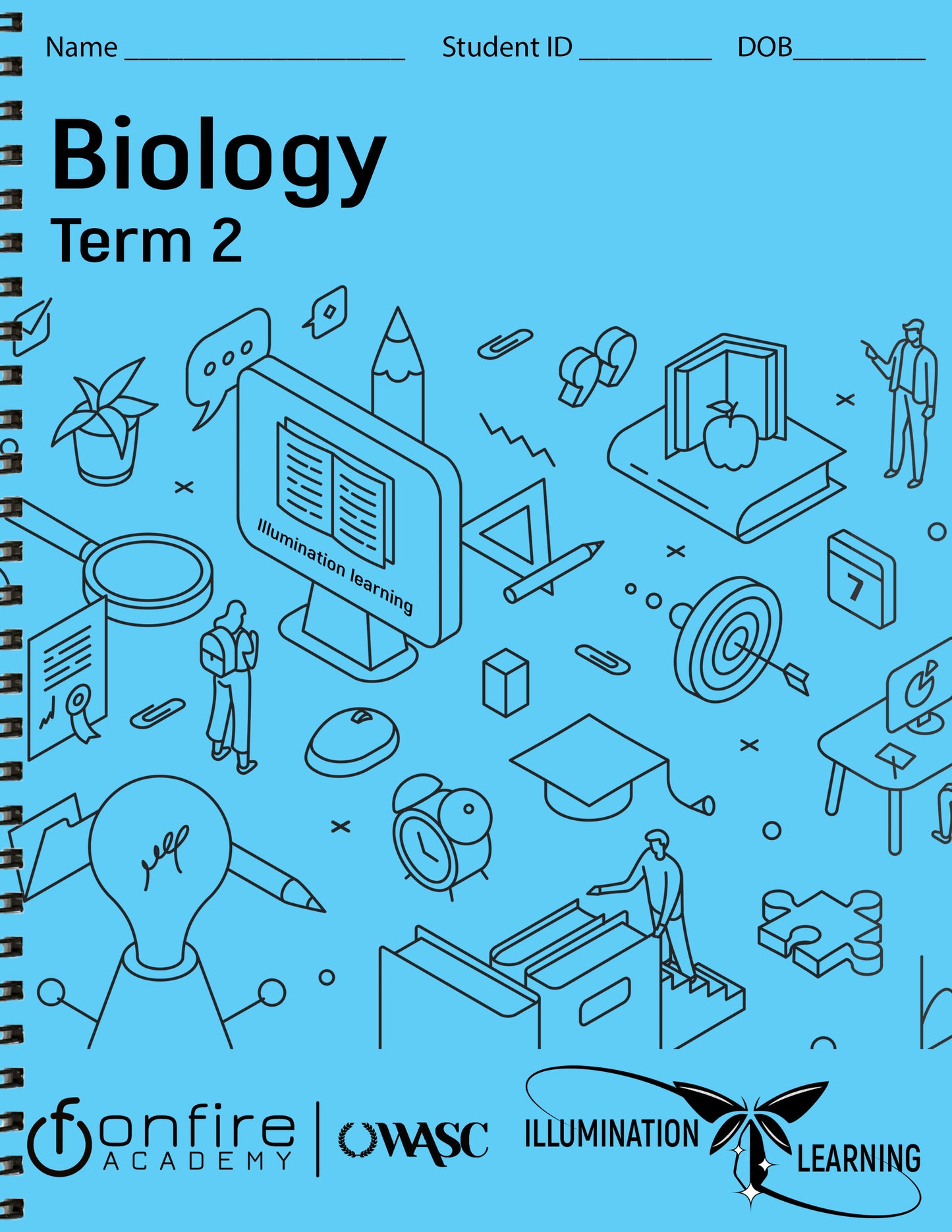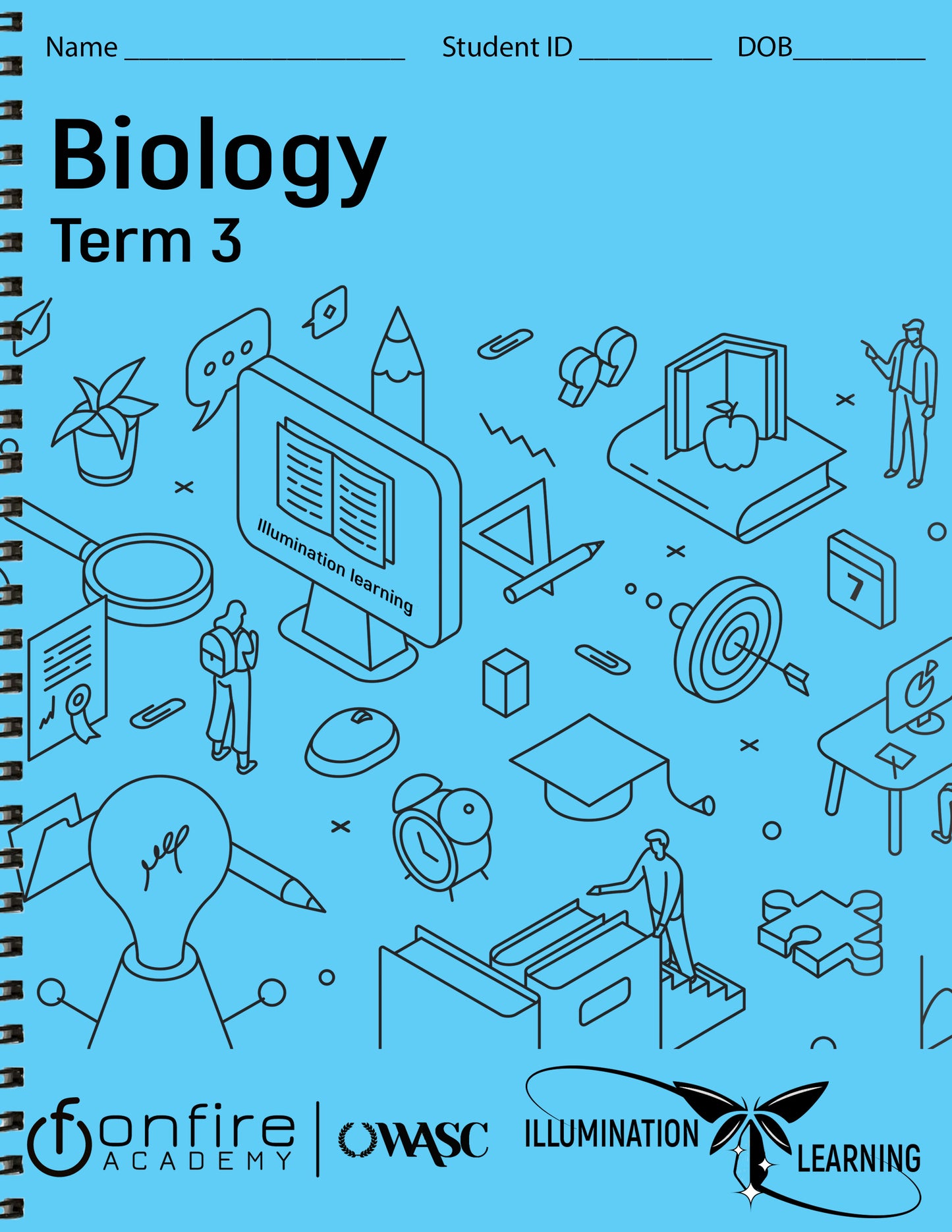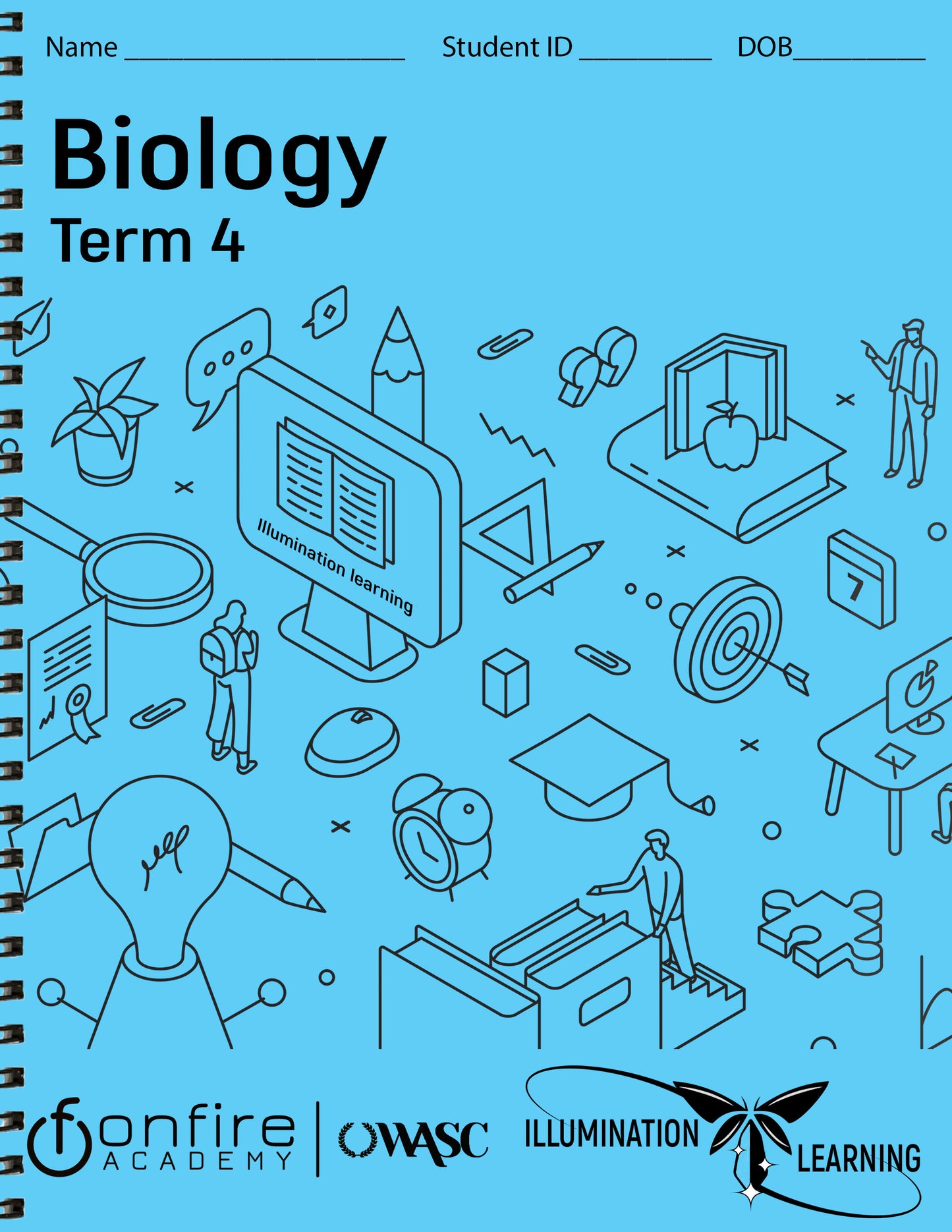ILLUMINATION LEARNING
Biology 𝘾𝙧𝙚𝙙𝙞𝙩
Biology 𝘾𝙧𝙚𝙙𝙞𝙩
Couldn't load pickup availability
Biology – Terms 1 - 4 (sold separately)
This paper and pencil course provides an in-depth study of living organisms and the processes that sustain life. Students explore major biological concepts including cell structure and function, molecular biology, genetics, evolution, ecology, and biodiversity. The course emphasizes the real-world relevance of biology through current examples and scientific applications.
Scientific inquiry is a key component of the course. Students engage in making observations, forming hypotheses, collecting and analyzing data, and communicating results. Lab experiences include a combination of virtual simulations, home-based experiments using everyday materials, and pre-recorded demonstrations, offering flexible and meaningful hands-on learning.
Throughout the four terms, students develop a strong foundation in biological science and improve their ability to think critically, solve problems, and collaborate. By the end of the course, students will have gained a deeper understanding of the principles of life and how biology connects to their daily experiences and future academic pursuits.
Click Here for a Sample Chapter!
_____________________________________________________________________________
Biology Term 1
Chapter 1 – Introduction to Biology and Field of Specialization
- 1.1 Levels of Biological Organization
- 1.2 Living World in Time
- 1.3 Service to Mankind
- 1.4 Conservation and Protection of the Environment
- Fill in the Blank Questions
- Written Questions
- Multiple Choice Questions
Chapter 2 – Biological Molecules
- 2.1 Introduction to Biochemistry
- 2.2 Importance of Carbon
- 2.3 Importance of Water
- 2.4 Proteins
- 2.5 Lipids
- 2.6 Carbohydrates
- 2.7 Nucleic Acids (RNA and DNA)
- 2.8 Conjugated Molecules
- Fill in the Blank Questions
- Written Questions
- Multiple Choice Questions
Chapter 3 – Enzymes
- 3.1 Characteristics of an Enzyme
- 3.2 Mechanism of Enzyme Catalysis
- 3.3 Factors Affecting Enzyme Action Rate
- 3.4 Inhibitors (Reversible and Irreversible)
- Fill in the Blank Questions
- Written Questions
- Multiple Choice Questions
Chapter 4 – The Cell
- 4.1 Structure of Generalized Cells (Nucleus, Cytoplasm, Organelles)
- 4.2 Eukaryotic and Prokaryotic Cells
- Fill in the Blank Questions
- Written Questions
- Multiple Choice Questions
Chapter 5 – Variety of Life
- 5.1 Two to Five Kingdom Classification Systems
- 5.2 Viruses (Structure, Life Cycle, Diseases)
- Fill in the Blank Questions
- Written Questions
- Multiple Choice Questions
Chapter 6 – Kingdom Prokaryotae
- 6.1 Bacteria Discovery
- 6.2 Bacteria Occurrence
- 6.3 Bacteria Structure (Flagella, Pili, Wall, Capsule, Spores, Granules)
- 6.4 Growth and Reproduction
- 6.5 Respiration in Bacteria
- 6.6 Nutrition in Bacteria
- 6.7 Importance of Bacteria (Medical, Ecological, Economic)
- 6.8 Bacterial Control (Chemical, Physical, Antibiotics)
- 6.9 Cyanobacteria Characteristics (Structure, Nostoc)
- Fill in the Blank Questions
- Written Questions
- Multiple Choice Questions
Chapter 7 – Kingdom Protista
- 7.1 Diversity of Protists
- 7.2 Major Protist Groups
- Protozoans (e.g., Apicomplexans, Foraminiferans, Ciliates, Zooflagellates, Amoebae)
- Algae (Green, Red, Brown, Diatoms, Dinoflagellates, Euglenoids)
- 7.3 Fungus-Like Protists (Oomycetes, Myxomycota)
- Fill in the Blank Questions
- Written Questions
- Multiple Choice Questions
_____________________________________________________________________________
Biology Term 2
Chapter 1 – Kingdom Animalia
- 1.1 Development of Complexity in Animals
- 1.2 Grade Bilateria
- 1.3 Grade Radiata
- 1.4 Triploblastic and Diploblastic Organization
- 1.5 Coelomates, Pseudocoelomates, and Acoelomates
- 1.6 Phylum: Chordata
- 1.7 Phylum: Hemichordata
- 1.8 Phylum: Echinodermata
- 1.9 Phylum: Mollusca
- 1.10 Phylum: Arthropoda
- 1.11 Phylum: Annelida
- 1.12 Phylum: Nematoda
- 1.13 Phylum: Platyhelminthes
- 1.14 Phylum: Cnidaria / Coelenterata
- 1.15 Phylum: Porifera
End-of-Chapter Questions – Chapter 1
- Written Questions
- Fill in the Blanks
- Multiple Choice Questions
Chapter 2 – Kingdom Plantae
- 2.1 Plantae Classification
- Division Tracheophyta
- Pteropsida (Angiospermae, Gymnospermae,
- Filicineae SphenopsidaLycopsida
- Division Bryophyta
- Subdivisions: Anthoceropsida, Bryopsida, Hepaticopsida
- Alternation of Generations
- Written Questions
- Fill in the Blanks
- Multiple Choice Questions
Chapter 3 – Bioenergetics
- 3.1 Photosynthesis
- 3.2 Chloroplasts
- 3.3 Photosynthetic Pigments
- 3.4 Role of Carbon Dioxide
- 3.5 Light and Photosynthesis
- 3.6 Photosynthesis Reactions
- Light-dependent reactions
- Chemiosmosis
- Light-independent reactions (Calvin Cycle)
- Respiration
- Glycolysis
- Krebs Cycle
- Electron Transport Chain
- Oxidative Phosphorylation
- Written Questions
- Fill in the Blanks
- Multiple Choice Questions
Chapter 4 – Nutrition
4.0 Visual Outline and Pre-Learning Activity
- Chapter mind map overview
- Checkmark familiar topics
- Star new topics
- Reflection question prompt
4.1 Heterotrophic Nutrition
Pages
Nutrition in Plants
- Symbiotic Nutrition
- Parasitic Nutrition
- Saprophytic Nutrition
- Insectivorous Nutrition
- Venus-Fly Trap
- Pitcher Plant
Nutrition in Animals
- Macrophagous Feeders
- Fluid Feeders
- Filter Feeders
- Omnivores
- Carnivores
- Herbivores
- Detritivores
- Parasitic Nutrition
4.2 Autotrophic Nutrition
- Mineral Nutrition in Plants
- Common fertilizers used in agriculture
- Mineral Element Deficiencies
- Nitrogen
- Phosphorus
- Potassium
- Magnesium
4.3 Absorption and DigestionDigestion in Organisms
- Cockroach
- Planaria
- Hydra
- Amoeba
Human Digestion
- Digestive System Overview
- Oral Cavity
- Food Selection
- Mastication
- Lubrication & Salivary Glands
- Swallowing
- Peristalsis
- Stomach Function & Secretions
- Small Intestine
- Duodenum, Jejunum, Ileum
- Digestive Enzymes and Absorption
- Pancreatic and Bile Functions
- Large Intestine and Rectum
- Water & Salt Absorption
- Bacterial Flora
- Fecal Formation and Elimination
Digestive Enzymes Table
- Enzymes, Substrates, and End Products
Organ Functions and Secretions Table
4.4 Common Diseases Associated with Nutrition
- Ulcer
- Piles (Hemorrhoids)
- Bulimia Nervosa
- Anorexia Nervosa
- Obesity
- Food Poisoning
- Salmonella, Campylobacter, Botulism
- Dyspepsia
- Fill in the Blank Questions
- Written Questions
- Multiple Choice Questions
_____________________________________________________________________________
Biology Term 3
About the Course
- Course Overview
- Intended Audience
- Types of Questions:
- Review Questions (Written & Multiple Choice)
- Critical Thinking Questions
Chapter 1: Gaseous Exchange
- 1.1 Importance of Respiratory Gas Exchange
- 1.2 Gas Exchange in Water and Air
- 1.3 Gas Exchange in Plants
- 1.4 Respiration in Animals (Birds, Frogs, Fish, Hydra, Humans)
- 1.5 Lung Capacity
- Written Questions
- Multiple Choice Questions
- Fill in the Blanks
Chapter 2: Transport of Material in Animals
- 2.1 Importance of Transport
- 2.2 Transport in Single-Celled Organisms
- 2.3 Circulatory Systems (Open vs. Closed)
- 2.4 Vertebrate Heart Evolution
- Written Questions
- Multiple Choice Questions
- Fill in the Blanks
Chapter 3: Transport of Material in Plants
- 3.1 Water & Mineral Uptake by Roots
- 3.2 Mineral Absorption
- 3.3 Absorption Processes
- 3.4 Water Uptake Pathways
- 3.5 Water Potential
- 3.6 Ascent of Sap
- 3.7 Types of Transpiration
- 3.8 Stomatal Behavior
- 3.9 Factors Affecting Transpiration
- 3.10 Transpiration as a Necessary Evil
- Written Questions
- Multiple Choice Questions
- Fill in the Blanks
Chapter 4: Translocation of Organic Solutes
- 4.1 Phloem Structure
- 4.2 Transport Patterns (Source to Sink)
- 4.3 Pressure-Flow Theory
- Written Questions
- Multiple Choice Questions
- Fill in the Blanks
Chapter 5: Transport in Humans
- 5.1 Circulatory System Components
- 5.2 Blood Composition & Function
- 5.3 Heart Structure & Function
- 5.4 Blood Vessels
- 5.5 The Cardiac Cycle
- 5.6 Blood Flow & Pressure
- 5.7 Circulatory Disorders
- Written Questions
- Multiple Choice Questions
- Fill in the Blanks
Chapter 6: Immunity, Its Types, and Diseases
- 6.1 Overview of Immunity
- 6.2 Types of Immunity (Innate, Acquired, Active, Passive)
- 6.3 Immune System Components
- 6.4 Diseases (AIDS, Cancer, Drug Use)
- Written Questions
- Multiple Choice Questions
- Fill in the Blanks
Chapter 7: The Human Lymphatic System
- 7.1 Digestive Function of the Lymphatic System
- 7.2 Cardiovascular Function
- 7.3 Immune Function
- 7.4 Lymphatic Diseases
- 7.5 Treatments
- Written Questions
- Multiple Choice Questions
- Fill in the Blanks
_____________________________________________________________________________
Biology - Term 4
Chapter 1: The Human Reproductive System
- 1.1 Female Reproductive System
- 1.2 Male Reproductive System
- 1.3 Gametogenesis
- 1.4 Menstrual Cycle
- 1.5 Fertilization and Implantation
- 1.6 Pregnancy and Embryo Development
- 1.7 Parturition and Lactation
- Written Questions
- Multiple Choice Questions
- Fill in the Blanks
Chapter 2: Reproductive Health in Human Beings
- 2.1 Problems and Strategies
- 2.2 Population and Birth Control
- 2.3 MTP (Medical Termination of Pregnancy)
- 2.4 STIs (Sexually Transmitted Infections)
- 2.5 Infertility
- Written Questions
- Multiple Choice Questions
- Fill in the Blanks
Chapter 3: Strategies for Enhancement in Food Production
- 3.1 Plant Breeding
- 3.2 Tissue Culture
- 3.3 Animal Husbandry
- Written Questions
- Multiple Choice Questions
- Fill in the Blanks
Chapter 4: Microbes in Human Welfare
- 4.1 Microbes in Industrial Products
- 4.2 Microbes in Household Products
- 4.3 Biofertilizers
- 4.4 Biocontrol Agents
- 4.5 Sewage Treatment
- Written Questions
- Multiple Choice Questions
- Fill in the Blanks
Chapter 5: Biotechnology: Principles and Processes
- 5.1 Principles of Biotechnology
- 5.2 Recombinant DNA Technology and Tools
- 5.3 Recombinant DNA Technology Processes
- Written Questions
- Multiple Choice Questions
- Fill in the Blanks
Chapter 6: The Ecosystem
- 6.1 Structure and Function
- 6.2 Nutrient Cycling
- 6.3 Ecosystem Services
- Written Questions
- Multiple Choice Questions
- Fill in the Blanks
Chapter 7: Biodiversity and Conservation
- 7.1 Biodiversity: Definition, Patterns, and Importance
- 7.2 Conservation Methods: In-Situ & Ex-Situ
- Written Questions
- Multiple Choice Questions
- Fill in the Blanks
Share







